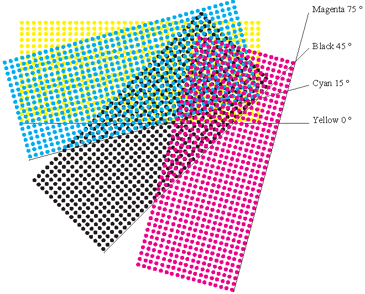Share this
Understanding the Uses and Benefits of Halftone (Stochastic) Screening
by Luminite on Nov 3, 2021 1:30:00 PM
Would it surprise you to know that the colors you see on some of the most popular consumer goods are actually just a “trick of the eye”?
Thanks to a printing technique called halftone screening (also referred to as stochastic screening), the color of your favorite brand's logo may actually be an optical illusion, fooling your eyes into seeing tones and colors that aren’t actually there.
Since most printing presses only handle 7 to 8 colors, press operators and image carrier manufacturers needed to engineer a way for presses to print a wide variety of colors without needing to add special color batches. The answer? Stochastic (halftone or FM) screening.
But how does halftone screening work? And how does it allow for thousands of color options?
Halftone Screening: The Optical Illusion You Never Knew Existed
With flexo printing technology being utilized to print most non-consumable products and product packaging, the need for a wide variety of colors, shades, and tones is clear. And since most brands use specific shades and tones of colors for their logos and packaging; flexo technology has been used to create copy-written, trademarked, and otherwise secretive colors for all of the popular brands.
Halftone screening or a series of dots aligned in an X/Y axis is set up along the grid of the image carrier. Each color gets its own “screen” or layer of dots that allow a graphic artist to specify the exact amount of ink (or no-ink) that will create the requested tone and shade.
The technical process of creating a screen can get a little murky for someone unfamiliar with the graphic art or image carrier production process. Essentially each dot is precisely located to either fill an area with a certain color or leave it blank. Multiply that by many thousands of dots and you produce a mesh of colors and tones.

Take a standard piece of paper and divide it into 4 quadrants, which creates the X/Y grid of your screen. Each dot corresponds with a certain color. To achieve your desired tone, multiple layers of screens can be added.
However, as the image to the right indicates, each screen needs to be rotated 15° in order to prevent the moiré effect.
Think of halftone screening like overhead projector transparency, each layer, or “screen”, can project only one color, so each layer of transparency is needed to achieve the full picture. In our case, each screen represents only one color, and layering those screens creates the illusion of tone and intensity of the color.
This technology effectively allows the graphic artist to specify any shade or tone of any color their branding calls for. It also allows your image carrier to create finely-tuned results after the fingerprinting process.
What are Halftones Screens?
We’ve covered the basic capabilities of halftone screening, but not the basic process of creating halftones, or what a halftone is for printing screens. Since the process of creating halftones can get complicated, you should consult a graphic design or software expert.
As we mentioned above, halftone screening is the process of printing several layers (screens) of dots with different colors at different layers. Since the screens are set up in a traditional X/Y pattern, printing one on top of another creates different angles that provide different colors. Some popular software options also have automated halftone screening options.
Having Issues with Your Halftone Screens?
The process of stochastic (FM) screening can get complicated, therefore it's important to work with experts in the printing field.
Luminite is a leading provider of image carrier services with a proven track record of high-quality products. For years, we’ve been producing educational resources, like this one, aimed at helping you solve common flexo printing problems. Check out the guide below for more information on flexo and getting you closer to the perfect print:
Share this
- Flexographic Printing (81)
- Image Carrier (28)
- Elastomer sleeves (27)
- Ink Transfer (25)
- Quality (22)
- Flexo sleeve (20)
- News (18)
- printing defects (18)
- flexo printing defects (17)
- sustainability (13)
- Flexo Troubleshooting (12)
- Ink (12)
- Digital Printing (10)
- Flexo 101 (10)
- Flexo Inks, (9)
- Anilox (7)
- Blister Packaging (7)
- Cost (6)
- print misregistration (6)
- regulations (6)
- Corrugated Printing (4)
- pinholing (4)
- "Tradeshow (3)
- Digital Flexo (3)
- Gravure Printing (3)
- Insider (3)
- Load-N-Lok (3)
- Wide Web (3)
- direct laser engraving (3)
- flexo-equipment-accessories (3)
- gear marks (3)
- halo (3)
- testing (3)
- Narrow Web (2)
- bridging (2)
- feathering (2)
- filling in (2)
- mottled image (2)
- pressure (2)
- Labelexpo (1)
- dirty prints (1)
- doughnuts (1)
- embossing (1)
- kiss impression (1)
- October 2023 (2)
- September 2023 (1)
- August 2023 (1)
- July 2023 (3)
- June 2023 (1)
- May 2023 (5)
- April 2023 (1)
- March 2023 (2)
- February 2023 (1)
- January 2023 (3)
- December 2022 (1)
- October 2022 (3)
- September 2022 (2)
- August 2022 (2)
- July 2022 (3)
- May 2022 (1)
- April 2022 (4)
- March 2022 (2)
- February 2022 (5)
- January 2022 (7)
- December 2021 (1)
- November 2021 (3)
- October 2021 (2)
- September 2021 (1)
- August 2021 (1)
- July 2021 (3)
- June 2021 (1)
- May 2021 (4)
- April 2021 (4)
- March 2021 (4)
- February 2021 (2)
- December 2020 (1)
- November 2020 (1)
- October 2020 (2)
- September 2020 (1)
- August 2020 (3)
- July 2020 (2)
- June 2020 (3)
- May 2020 (1)
- April 2020 (1)
- November 2019 (3)
- October 2019 (1)
- August 2019 (1)
- July 2019 (1)
- April 2019 (1)
- March 2019 (1)
- January 2019 (1)
- October 2018 (2)
- August 2018 (1)
- July 2018 (1)
- June 2018 (1)
- February 2018 (2)
- October 2017 (1)
- September 2017 (2)
- January 2016 (1)
- February 2015 (1)
- January 2015 (1)
- December 2014 (2)
- September 2014 (1)
- February 2014 (1)
- January 2014 (1)
- December 2013 (3)
- October 2013 (1)
- September 2013 (1)
- June 2013 (1)
- January 2013 (1)


Comments (2)